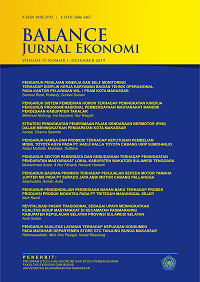The Effect of Labor Movement or Migration on the Indonesian Economy
DOI: https://doi.org/10.26618/jeb.v20i2.13184
Perpindahan, Migrasi Tenaga Kerja, Perekekonomian Indonesia
Abstract
This article examines the impact of migration and labor movement on the Indonesian economy, highlighting key areas such as economic growth, employment, consumer spending, and remittances from migrant workers. Labor migration has been a significant aspect of Indonesia’s economic structure, affecting both the domestic labor market and the broader economic landscape. The article explores how the outflow of Indonesian workers abroad influences employment dynamics, with some sectors benefiting from reduced domestic competition, while others experience labor shortages. Additionally, remittances from migrant workers play a crucial role in boosting household income, contributing to consumer spending, and stimulating local economies in various regions. The study also delves into the Indonesian government's policies and initiatives aimed at managing labor migration, including the protection of migrant workers' rights, improving workforce skills, and addressing challenges related to illegal migration. By analyzing the multifaceted impacts of labor migration, this article provides a comprehensive understanding of its role in shaping Indonesia's economic development. The findings suggest that while labor migration offers significant benefits through remittances and economic growth, challenges such as labor exploitation and brain drain require effective policy responses to maximize the positive impacts on the national economy.
References
Borjas, G. J. (1994). The Economics of Immigration. Journal of Economic Literature, 32(4), 1667-1717.
Czaika, M., & de Haas, H. (2014). The Role of External and Internal Factors in the Migration–Development Nexus. Population, Space and Place, 20(4), 340-358.
Constant, A. F., Nottmeyer, O., & Zimmermann, K. F. (2012). The Effect of Diasporas on Migrants’ Labor Market Outcomes: Evidence from Germany. International Migration Review, 46(1), 51-78.
de Haas, H. (2008). The Internal Dynamics of Migration Processes: A Theoretical Inquiry. The International Migration Review, 42(4), 656-685.
Endang, P. D., & Idris. (2019). The Influence of Labor In-migration and Human Development to Economic Growth in Indonesia. Journal of Economic and Development Studies, 1(2), 262.
Lee, E. S. (1966). A Theory of Migration. Demography, 3(1), 47-57.
Massey, D. S., Arango, J., Hugo, G., Kouaouci, A., Pellegrino, A., & Taylor, E. J. (1993). Theories of International Migration: A Review and Appraisal. Population and Development Review, 19(3), 431-466.
Mita, N. (2017). Migration Recurring Labor Migrant International. Journal Population of Indonesia, 12(1), 25-38.
Muttaqien, A. Z., et al. (2023). Analysis of Labor Migration in the Economic Sector in the Regency of Agung. Journal of Creative Student Research, 1(4), 357.
Rahmany, S., & IMESy, E. (2011). Analysis of Factors Affecting Labor Working Abroad. Journal of Scientific Law, 5(1), 1-10.
Sjaastad, L. A. (1962). The Costs and Returns of Human Migration. Journal of Political Economy, 70(5), 80-93.
Sudarwati, Y. (2014). Indonesia's Efforts to Face Labor Migration within the ASEAN Economic Community (AEC) 2015. Journal of Economics & Public Policy, 5(1), 28.
The Global Commission on International Migration. (2005). Migration in an Interconnected World: New Directions for Action.
Van Hear, N., Bakewell, O., & Long, K. (2012). Migration and Development: The Global Perspective. Oxford University Press.
World Bank. (2011). The World Bank’s Role in International Migration.












